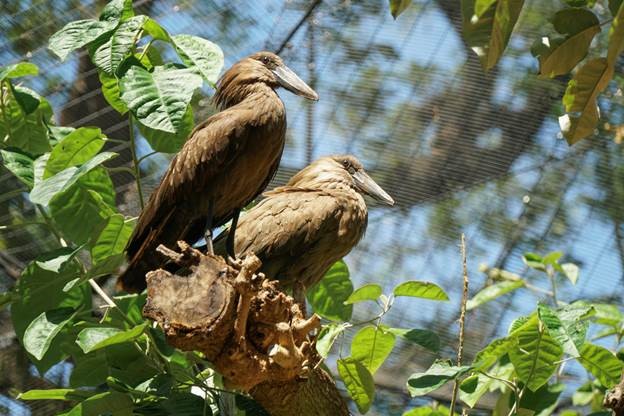Community website by MBC/Ernest Abrams. Call 808-739-9797 for advertising/sponsorship.
Waikiki Get Down - Honolulu, Hawaii
News Item- Powered by MBC NewsMaker
Two hamerkops now on display at Honolulu Zoo
- Tweet

The hamerkops in the zoo’s walk-in aviary.
The Honolulu Zoo is welcoming members of the public to view its two newest additions, two hamerkops that have created a new breeding pair. The male hamerkop came from the Dallas Zoo, while the female bird came from the San Diego Zoo. Both hamerkops are almost two years old.
To download additional photos of the new hamerkops, please follow this link: https://drive.google.com/open?id=12I3VhcaMcnyb7O-y_g4ET1tRnkBJ9NqP
“Although hamerkops are not threatened with extinction, having these birds in our zoo provides visitors the opportunity to see these animals up close without having to rely on a video, which just isn’t the same,” said Honolulu Zoo Director Linda Santos. “These birds are very impressive to see in person, and I urge our local residents and visitors to come take a look for themselves.”
Hamerkops, named after their hammer-shaped head, are actually the world’s smallest stork. These birds are not globally threatened and are locally abundant in Africa and Madagascar. Hamerkops can live up to 20 years and grow to approximately two feet tall. These wading birds are most commonly found in woodlands and wetlands in the wild, and feed on frogs, small fish, and crustaceans.
Hamerkops are diurnal (active during daylight hours) and are typically found in pairs. They are known for their very large multi-chambered nests constructed of mud, sticks, grasses and plants. In fact, nests can contain over 10,000 sticks and may reach the size of a large refrigerator, weighing approximately 50 to 100 pounds. The hollow chamber design is so structurally sound, it can support the weight of an adult person.
The Honolulu Zoo has successfully bred and hatched 14 hamerkops since 1996, but has not exhibited a hamerkop since the last one, named MC, died in 2014. The Honolulu Zoo plans to breed the two new hamerkops as part of the Association of Zoos and Aquariums (AZA) Species Survival Plan (SSP). They are currently on display in the walk-through aviary in the Honolulu Zoo’s African Savana.
Questions? Ready for an appointment?
Featured Product/Service
- RELATED LINKS
Calendar
Check out things to do in Waikiki, Hawaii on the calendar of events.News and Newsletters
Keep up with the latest news and happenings in the Waikiki, Hawaii community.Waikiki, Hawaii Featured Pages
View our directory of feature pages showcasing all the great things Waikiki has to offer.Featured Sponsors Offers
Great offers from our sponsors who support the Waikiki, Hawaii Community More...Waikiki, Hawaii Coupons & Discounts
Save money in Waikiki, Hawaii with these coupons.About Waikiki - Honolulu Hawaii
Learn about Waikiki, Hawaii.About Waikiki Get Down.com
Learn about WaikikiGetDown.com website and its creator.
Please send questions about this website to
Copyright© 2012 - 2019 WaikikiGetDown.com. All rights reserved.
Terms of Use / Legal Disclaimer / Privacy Statement
Site Designed and Managed by MacBusiness Consulting
Terms of Use / Legal Disclaimer / Privacy Statement
Site Designed and Managed by MacBusiness Consulting
